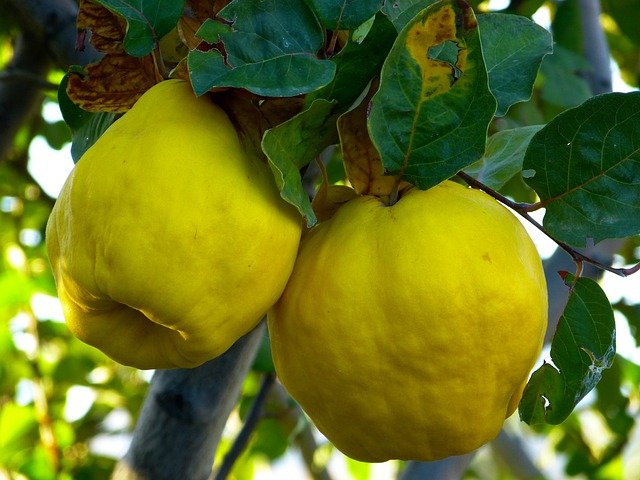
Quince is an unfairly forgotten fruit of autumn, with many beneficial properties. Let’s see what are the main qualities of quince and how we can use it in our kitchen.
Quince is a typically autumn fruit that belongs to the pome family, the same as apple and pear. According to the variety it can be maliform or pear-shaped. It is a little used fruit and it is often difficult to find it, especially in large distribution.
It can be bought especially in the countryside of southern Italy, especially in Puglia, Sicily, Campania and Basilicata; in reality, however, it is grown almost everywhere in our country. The poor success of quince probably depends on its characteristics; in fact, it is very hard and it is difficult to eat it raw.
It would be advisable to take advantage of the autumn months to consume this fruit and perhaps stock up on quince-based jams, to be kept in the pantry all year round. Quince, in fact, is a concentrate of properties and especially helps cardiovascular and gastrointestinal well -being.
Quince: nutritional values
Quince, like many other fruits, is rich in water and fiber while it has a very low fat and protein content. Calories are few: 100 grams of quince provide only 38 Kcal. Among the fibers present in quince, pectin is well represented, a soluble dietary fiber with gelatinizing, stabilizing and thickening properties which, thanks to these qualities, helps to keep blood sugar and cholesterol levels under control.
From the point of view of micronutrients, however, quince contains some minerals, including potassium and phosphorus, and some vitamins, in particular vitamin C and some B vitamins.
Nutritional values per 100g of quince:
- Waterfall: 84.3 g
- kcal: 38
- Proteins: 0.3 g
- Fat: 0.1 g
- Carbohydrates: 6.3 g
- Fibers: 5.9 g
- Potassium: 200 mg
- Phosphorus: 14 mg
- C vitamin: 14 mg
- Vitamin B1: 0.02 mg
- Vitamin B2: 0.03 mg
- Glycemic index: 35
- Cholesterol: 0 g
The beneficial properties of quince
Quince is especially good for the digestive system, but not only. Let’s see below an in-depth analysis of all the benefits of this fruit.
✓ Antioxidant
Quince is rich in antioxidant compounds including some flavonols such as quercetin and kaempferol that help reduce inflammation and protect against chronic diseases, including heart disease. Furthermore, antioxidants protect cells from damage by free radicals, unstable molecules that can damage their structure.
✓ Beneficial for the cardiovascular system
As we have seen, quince is a good source of fiber, substances that are important for cardiovascular health as they reduce the absorption of cholesterol. Furthermore, the presence of antioxidants helps prevent the oxidation of LDL cholesterol in the arteries and, consequently, helps reduce cardiovascular risk. Finally, the good presence of potassium gives the fruit diuretic properties, which are therefore useful for regulating pressure.
✓ Quince for the well-being of the digestive system
The high pectin content of quince helps to preserve and restore intestinal motility. Furthermore, this fruit contains a good amount of malic acid, a substance that promotes digestion and can boast anti- inflammatory properties affecting the intestine and stomach. To this end, recent researches seem to attribute to quince useful properties in contrasting inflammatory bowel diseases.
✓ Useful against gastric reflux
Some recent research has found quince juice to reduce symptoms related to GERD. Specifically, a study carried out on some children with reflux showed that daily supplementation with quince juice would be as effective as the drugs traditionally used to relieve the symptoms of this condition. In this regard, however, further studies are needed to investigate this property of quince.
✓ Potential ally against ulcer
Compounds derived from quince have been shown to have promising anti-ulcer effects. Specifically, in a recent study, quince juice inhibited the growth of the bacterium Helicobacter pylori, which is known to cause stomach ulcers. Furthermore, quince extracts have been shown to protect the stomach from alcohol-induced gastric ulcer.
How to eat quince
Unlike other fruits that can be used raw in pastry doughs, quince, having a very hard pulp and a rather sour taste, is best eaten after cooking. To cook the quince it is necessary to cut it, if necessary remove the peel and put it in a pot with water (you can optionally add a little sugar). Then let it simmer for a few minutes, until the pulp has softened. Alternatively, they can also be baked in the oven. In this case, after cutting them, they should be baked at 180 ° C for a few minutes, until the pulp becomes tender.
If you like, you can also experiment with adding some spices, including vanilla, cinnamon, ginger and star anise. The juice obtained from cooking quince can be used as a liquid part of the dough.
How to use quince
As we have just seen, quince is usually eaten cooked. After cooking, it can be eaten at the end of a meal, for breakfast (for example with yogurt) or as a mid-morning or mid-afternoon snack. Quince cooked in this way is also a great ingredient for making autumn-flavored cakes and pies.
Furthermore, quince is particularly suitable for the preparation of preserves. The one obtained only with this fruit is called quince; it has a gelatinous appearance and is often used to fill pies or to obtain filled biscuits.
Quince also helps in the preparation of excellent jams based on other fruits; a quince added to a kilo of other fruit helps to thicken the jam without the need to use other gelatinizing products. It is, therefore, a valid ally for those who want to prepare completely natural jams at home.






